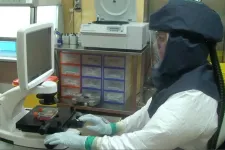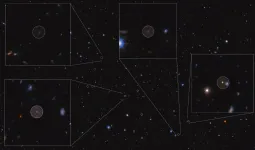(Press-News.org) Climate alone is not a driver for human behavior. The choices that people make in the face of changing conditions take place in a larger human context. And studies that combine insights from archaeologists and environmental scientists can offer more nuanced lessons about how people have responded -- sometimes successfully -- to long-term environmental changes.
One such study, from researchers at Washington University in St. Louis and the Chinese Academy of Sciences, shows that aridification in the central plains of China during the early Bronze Age did not cause population collapse, a result that highlights the importance of social resilience to climate change.
Instead of a collapse amid dry conditions, development of agriculture and increasingly complex human social structures set the stage for a dramatic increase in human population around 3,900 to 3,500 years ago.
"In China, especially, there has been a relatively simplistic view of the effects of climate," said Tristram R. "T.R." Kidder, the Edward S. and Tedi Macias Professor of Anthropology in Arts & Sciences. The new study was posted online in Environmental Research Letters.
"Our work shows that we need to have a nuanced appreciation of human resilience as we consider the effects of climate and its effects on human societies," Kidder said. "We have remarkable capacity to adapt. But part of the lesson here is that our social, political and technological systems have to be flexible.
"People in the past were able to overcome climate adversity because they were willing to change," he said.
The new study is one of the first attempts to quantify the types and rates of demographic and subsistence changes over the course of thousands of years in the central plains of China.
By combining information about climate, archaeology and vegetation, the authors mapped out an ambitious story about what changed, when it changed and how those changes were related to human social structures at the time.
Researchers used pollen data from a lake sediment core collected in Henan Province to interpret historical climate conditions. In this area, they found that a warm and wet climate about 9,000 to 4,000 years ago shifted to a cool and dry climate during the Neolithic-Bronze Age transition (about 4,000 to 3,700 years ago). The researchers then used radiocarbon dating and other archaeological data to determine what people were growing and eating during periods of significant population surges and declines in this timeframe.
Confronted with the fluctuation and limitation of resources caused by episodes of climatic aridification, people expanded the number of plants they cultivated for food, the researchers found. They embraced new diversity in agriculture -- including foxtail millet, broomcorn millet, wheat, soybean and rice -- all of which reduced the risks of food production.
This also was a time marked by innovations in water management approaches for irrigation, as well as new metal tools. Social structures also shifted to accommodate and accelerate these examples of human adaptive ingenuity.
"Certainly, by 4,000 years ago, which is when we see this change in the overall environmental condition, this is a society with complicated political, social and economic institutions," Kidder said. "And what I think we are seeing is the capacity of these institutions to buffer and to deal with the climatic variation. When we talk about changes in subsistence strategies, these changes didn't happen automatically. These are human choices."
With this and other related research work, Kidder has argued that early Chinese cities provide an important context that closely resembles modern cities, where high-density urbanism is supported by intensive agriculture. They provide a better historical analog than the Maya world or those in southeast Asia, notably Angkor Wat and the Khmer Kingdom. Those were cities where lower density and food production did not put the same sorts of demands on the physical environment.
Lead author Ren Xiaolin, assistant professor at the Institute for the History of Natural Sciences at the Chinese Academy of Sciences in Beijing, worked closely with Kidder and others in his laboratory to develop the theory and framework for how to think about environmental changes and urbanism in China.
"Climate change does not always equal collapse -- and this is an important point in both a prehistoric and modern context," said Michael Storozum, another co-author and research fellow at The Hebrew University of Jerusalem. Storozum is a PhD graduate of Washington University, where he studied under Kidder.
"Humans have been heavily modifying their environments for thousands of years, often in the pursuit of increasing food production which grants societies a higher degree of social resilience," Storozum said.
He draws connections between the findings from this paper and his current research as part of The Wall project, a study of people and ecology in medieval Mongolia and China.
"As more environmental scientists and archaeologists work together, I expect that our understanding of what makes a society resilient to climate change in prehistoric and historical times will grow as well," Storozum said.
Kidder added: "We need to think carefully about how we understand the capacity of people to change their world."
INFORMATION:
URBANA, Ill. - Economists and urban planners generally agree that local pollution sources disproportionally impact racial minorities in the U.S. The reasons for this are largely unclear, but a University of Illinois study provides new insights into the issue.
"Our work finds experimental evidence that racial discrimination in the home-renting process actively sorts minority renters into neighborhoods with higher levels of pollution," says Peter Christensen, assistant professor in the Department of Agricultural and Consumer Economics (ACE) and an affiliate in Center for the Economics of Sustainability at University of Illinois.
Christensen and co-authors Ignacio Sarmiento-Barbieri, U of I, and Christopher Timmins of Duke University conducted an empirical ...
Challenging the idea that older people with shorter life expectancies should rank lower in coronavirus immunization efforts, new UC Berkeley research shows that giving vaccine priority to those most at risk of dying from COVID-19 will save the maximum number of lives, and their potential or future years of life.
The findings, published Feb. 25 in the journal Proceedings of the National Academy of Sciences, address the ethical dilemma of who should be first in line for a limited supply of vaccine shots amid a contagion that so far has killed 500,000 in the United States and 2.4 million globally.
"Since older age is accompanied by falling life expectancy, it is widely assumed that means we're saving fewer years of life," said study lead author Joshua Goldstein, a UC Berkeley ...
Scientists at UCL and the IIT -Istituto Italiano di Tecnologia (Italian Institute of Technology) have created a temporary tattoo with light-emitting technology used in TV and smartphone screens, paving the way for a new type of "smart tattoo" with a range of potential uses.
The technology, which uses organic light-emitting diodes (OLEDs), is applied in the same way as water transfer tattoos. That is, the OLEDs are fabricated on to temporary tattoo paper and transferred to a new surface by being pressed on to it and dabbed with water.
The researchers, who ...
The investigation of Electron-Positron-Ion (EPI) plasma?--?a fully ionised gas of electrons and positrons that includes astrophysical plasmas like solar winds?--?has attracted a great deal of attention over the last twenty years. A new study published in EPJ D by Garston Tiofack, Faculty of Sciences, University of Marousa, Cameroon, and colleagues, assesses the dynamics of positron acoustic waves (PAWS) in EPI plasmas whilst under the influence of magnetic fields, or magnetoplasmas.
The authors studied the changes in PAWs using a framework of Korteweg-de Vries (KdV) and modified Korteweg-de Vries (mKdV) equations finding a former led to compressive positron acoustic solitary waves (PASWs), whilst the latter resulted in the same and additional rarefactive ...
The total amount of data generated worldwide is expected to reach 175 ZB (Zettabytes; 1 ZB equals 1 billion Terabytes) by 2025. If 175 ZB were stored on Blu-ray disks, the disk stack would be 23 times the distance to the Moon. We face the urgent need to develop storage technologies that can accommodate this enormous amount of data.
The demand to store ever-increasing volumes of information has resulted in the widespread implementation of data centers for Big Data. These centers consume massive amounts of energy (about 3% of global electricity supply) and rely on magnetization-based ...
IRS refers to the application of insecticide onto the interior walls of houses.
The study, by the Wits Research Institute for Malaria (WRIM) and the London School of Hygiene and Tropical Medicine (LSHTM), was published in The Lancet on 25 February 2021.
Targeted vs blanket Indoor Residual Spraying
Malaria still represents one of the world's largest health crises, particularly on the African continent where 94% of cases and deaths occur (World Health Organization, 2020).
Most countries in southern Africa have set the elimination of malaria within their borders as a policy target.
In ...
Prior to the emergence of new mutants of the coronavirus, such as the British variant B.1.1.7, the SARS-CoV-2 variant named D614G had already mutated from the original SARS-CoV-2 pathogen that triggered the pandemic. D614G has rapidly spread to become the most abundant variant worldwide and this D614G mutation remains in all the new emerging variants. An international team including researchers from Bern has now been able to demonstrate in both the laboratory and in animal models why the D614G variant was able to gain the upper hand over the original SARS-CoV-2 virus. "Our approach ...
A study, led by researchers at the Instituto de Astrofísica de Canarias (IAC) and carried out with OSIRIS, an instrument on the Gran Telescopio Canarias (GTC), has found the most densely populated galaxy cluster in formation in the primitive universe. The researchers predict that this structure, which is at a distance of 12.5 billion light years from us, will have evolved becoming a cluster similar to that of Virgo, a neighbour of the Local Group of galaxies to which the Milky Way belongs. The study is published in the specialized journal Monthly Notices of the Royal Astronomical Society (MNRAS).
Clusters of galaxies are groups of galaxies which remain together because of the action of gravity. To understand the evolution of these "cities of galaxies" scientists look ...
Researchers from the Andalusian Centre for Molecular Biology and Regenerative Medicine (CABIMER), in collaboration with the Swiss Institute for Experimental Cancer Research (ISREC) have studied the mechanisms behind the higher tendency of people with Mulibrey syndrome to develop tumours. Their results point to the important role of the TRIM37 protein, whose absence explains the appearance of tumour cells.
Mulibrey syndrome is a so-called rare disease as it occurs in less than 5 out of every 10,000 inhabitants. Some of these diseases usually have a very definite genetic basis. ...
If light is strongly concentrated in time and space, resulting in extreme photon densities, it can enable interaction with all conceivable materials. By using these ultrashort laser foci, even transparent materials can be modified, even though they ordinarily would not interact. Short, focused laser pulses can overcome this transparency and allow energy to be deposited completely contact-free. The exact response of the material to the radiation can be very diverse, ranging from marginal refractive index changes to destructive microscale explosions that evacuate entire areas.
Using the laser pulses for optical machining allows for equally diverse material modification, such as separating or joining using the same laser system. Due to the extremely short exposure time and low degree ...



